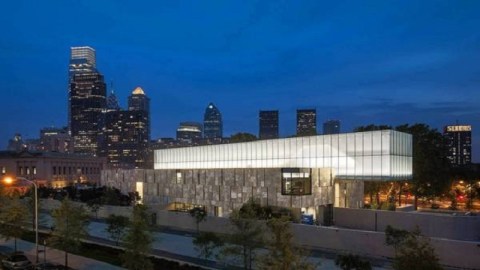How to Open a New Old Museum

In 1923, during an exhibition of his art collection that would become the Barnes Foundation in Merion, Pennsylvania, two years later, Dr. Albert C. Barnes told an interviewer, “I am trying to do the biggest thing for Philadelphia that any one man has attempted.” Nearly nine decades later, the grand reopening of the Barnes Foundation in its new location on the Benjamin Franklin Parkway in Philadelphia is attempting something even bigger—the opening of a new old museum that will make both the fans of the old place and fans of the new place both happy. With a beautiful new $150 million USD building and campus surrounding Dr. Barnes’ priceless old collection, it’s hard for anyone to complain.
Barnes built his collection from 1912 through his death in 1951 by taking the riches he’d amassed as the inventor of Argyrol and spending it on art. Thanks to the guidance of his friend, the artist William Glackens, and others, Barnes got in on the ground floor of 20th century modernism. The results are impressive: 181 works by Renoir, 59 works by Matisse, 69 works by Cezanne, 46 works by Picasso, and 7 works by Van Gogh. In addition to these emerging masters, Barnes recognized oddball artists not accepted at the time such as Chaim Soutine (21 works) and nearly forgotten Old Master El Greco (4 works). An amateur anthropologist as well as art connoisseur, Barnes collected artifacts from African, Native American, New Mexican, and even Pennsylvania Dutch cultures. Barnes’ eclectic, eccentric eye extended even to the presentation of the works on the walls of his galleries in “ensembles” that accentuated possible connections between them—an African mask might sit beside a Picasso or the flowing curves of a wrought iron door hinge would rest beside one of Renoir’s curvy bathers.
Lovers of the collection as it stood in the original building will recognize that Dr. Barnes’ ensembles have been replicated to the inch in the new building, with one notable exception: Matisse’s The Joy of Life no longer hangs awkwardly and inaccessibly along a staircase. Instead, the landmark work resides joyfully and ADA-compliantly in a large gallery, flanked by tapestries by Picasso and Georges Rouault.Another welcome change is the lighting—a mix of natural and artificial light much more favorable than at the old building. When artist Ellsworth Kelly (whose Barnes Totem stands outside the building) toured the collection weeks ago, he thought the paintings must have been cleaned to be so much more colorful than ever before.
Barnes’ eccentric ensembles, whether you love them or hate them, will remain forever as they stood when he died in a car accident in 1951. Explanatory wall plaques are still forbidden, but those seeking more information about a work can pick up one of the helpful booklets provided in each room. So, the thematic, experiential educational experience Barnes hoped for his guests continues. The inaugural special exhibition, Ensemble: Albert C. Barnes and the Experiment in Education, emphasizes the educational mission of the foundation as much as the two multimedia classrooms discreetly hidden amidst the recreated galleries.
I confess to not being an originalist when it comes to the Barnes Foundation. As the Ensemble exhibit proves through archival photos, Barnes continually rearranged his ensembles and would have continued to do so had he lived longer. Preserving this one arrangement seems like freezing something that was meant to be continually flowing—ever changing to meet the educational needs of the times. In that sense, a true “originalist” would be in favor of changes to the Barnes Foundation, both big and small. Barnes couldn’t have imagined iPod touch audio guides when he died in 1951, but I think he’d approve of their use now to reach new generations who take such things for granted. I also think that Barnes would have approved of the increased financial stability of his foundation, which approved this drastic move over a decade ago primarily as a means of economic survival. As one of the trustees said proudly at the press preview, the new building opens “debt free,” which is no small feat in today’s economic climate. Add in all the new amenities of modern lighting and climate control and Barnes’ vision seems stronger and safer than ever.
The building itself is remarkably beautiful inside and out. Reflecting pools stretch around the exterior and even in one large interior court. Atrium gardens inside the gallery section as well as Parisian style gardens outside recreate the natural climate of the old building and even add to it. But the focus of the Barnes Foundation will always be the art. Crowds will continue to flock to the big names of Renoir, Cezanne, Picasso, and Van Gogh, but it’s always the little treasures that catch my eye: a Degas pastel vibrating with intense color in the shadows of a doorway or a series of Cezanne’s ghostly delicate watercolors in a less-visited gallery.
On this visit my eye lingered on a 1941 painting by Aristodimos Kaldis titled Absorbing Art. Kaldis, a Turkish-born, leftist artist who hung around with Willem de Kooning and other New York School artists, painted an African-American man in a suit and tie sitting on a museum bench and drinking in the art surrounding him. I knew little about Kaldis, but seeing that work in the context of the Barnes Foundation, which began as a way to expose the African-American workers in Barnes’ factory to culture, I had to learn more. It’s magical little moments like that—for everyone from small children up to even for the most jaded art critic—that will keep the new Barnes Foundation building open and running for many years to come.
[Image: View of the Barnes Foundation looking south east at night. The Barnes Foundation Philadelphia. © 2012 Tom Crane.]
[Many thanks to the Barnes Foundation for providing the image above and other press materials as well as for inviting me to the press preview.]





